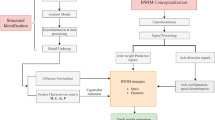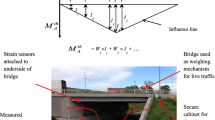Abstract
A real-time vehicle monitoring is crucial for effective bridge maintenance and traffic management because overloaded vehicles can cause damage to bridges, and in some extreme cases, it will directly lead to a bridge failure. Bridge weigh-in-motion (BWIM) system as a high performance and cost-effective technology has been extensively used to monitor vehicle speed and weight on highways. However, the dynamic effect and data noise may have an adverse impact on the bridge responses during and immediately following the vehicles pass the bridge. The fast Fourier transform (FFT) method, which can significantly purify the collected structural responses (dynamic strains) received from sensors or transducers, was used in axle counting, detection, and axle weighing technology in this study. To further improve the accuracy of the BWIM system, the field-calibrated influence lines (ILs) of a continuous multi-girder bridge were regarded as a reference to identify the vehicle weight based on the modified Moses algorithm and the least squares method. In situ experimental results indicated that the signals treated with FFT filter were far better than the original ones, the efficiency and the accuracy of axle detection were significantly improved by introducing the FFT method to the BWIM system. Moreover, the lateral load distribution effect on bridges should be considered by using the calculated average ILs of the specific lane individually for vehicle weight calculation of this lane.
Similar content being viewed by others
References
Pais J C, Amorim S I, Minhoto M J. Impact of traffic overload on road pavement performance. Journal of Transportation Engineering, 2013, 139(9): 873–879
Rys D, Judycki J, Jaskula P. Analysis of effect of overloaded vehicles on fatigue life of flexible pavements based on weigh in motion (WIM) data. International Journal of Pavement Engineering, 2016, 17(8): 716–726
Yu Y, Cai C S, Deng L. State-of-the-art review on bridge weigh-in-motion technology. Advances in Structural Engineering, 2016, 19(9): 1514–1530
Ojio T, Carey C H, O’Brien E J, Doherty C, Taylor S E. Contactless bridge weigh-in-motion. Journal of Bridge Engineering, 2016, 21(7): 04016032
Zhao H, Uddin N, O’Brien E J, Shao X, Zhu P. Identification of vehicular axle weights with a bridge weigh-in-motion system considering transverse distribution of wheel loads. Journal of Bridge Engineering, 2014, 19(3): 04013008
Zhao H, Uddin N, Shao X, Zhu P, Tan C. Field-calibrated influence lines for improved axle weight identification with a bridge weigh-in-motion system. Structure and Infrastructure Engineering, 2015, 11(6): 721–743
Lydon M, Taylor S E, Robinson D, Mufti A, Brien E J O. Recent developments in bridge weigh in motion (B-WIM). Journal of Civil Structural Health Monitoring, 2016, 6(1): 69–81
Snyder R, Moses F. Application of in-motion weighing using instrumented bridges. Transportation Research Record: Journal of the Transportation Research Board, 1985, 1048: 83–88
Park M S, Lee J, Kim S, Jang J H, Park Y H. Development and application of a BWIM system in a cable-stayed bridge. In: Proceedings of the 3rd International Conference on Structural Health Monitoring of Intelligent Infrastructure (SHMII-3). Vancouver: International Society for Structural Health Monitoring of Intelligent Infrastructure (ISHMII), 2007, 13–16
O’Brien E J, Znidaric A, Ojio T. Bridge weigh-in-motion—Latest developments and applications worldwide. In: Proceedings of the International Conference on Heavy Vehicles. Paris: John Wiley & Sons, Inc., 2008, 19–22
Schmidt F, Jacob B, Servant C, Marchadour Y. Experimentation of a bridge WIM system in France and applications for bridge monitoring and overload detection. In: The 6th International Conference on Weigh-In-Motion (ICWIM6). Dallas: International Society for Weigh in Motion (ISWIM), 2012
Lydon M, Robinson D, Taylor S E, Amato G, Brien E JO, Uddin N. Improved axle detection for bridge weigh-in-motion systems using fiber optic sensors. Journal of Civil Structural Health Monitoring, 2017, 7(3): 325–332
Sekiya H, Kubota K, Miki C. Simplified portable bridge weigh-in-motion system using accelerometers. Journal of Bridge Engineering, 2018, 23(1): 04017124
Peters R J. AXWAY—A system to obtain vehicle axle weights. In: Australian Road Research Board Conference. Hobart: ARRB Group Limited, 1984
Peters R J. CULWAY, an unmanned and undetectable highway speed vehicle weighing system. In: Australian Road Research Board Proceedings. Adelaide: Australian Road Research Board (ARRB), 1986, 70–83
O’Brien E J, Znidaric A, Baumgärtner W, González A, McNulty P. Weighing-In-Motion of Axles and Vehicles for Europe (WAVE) WP1. 2: Bridge WIM Systems. Dublin: University College Dublin, 2001
Jacob B, O’Brien E J, Jehaes S. Weigh-in-motion of Road Vehicles: Final Report of the Cost 323 Action. Laboratoire Central des Ponts et Chausees (LCPC), 2002
Moses F. Weigh-in-motion system using instrumented bridges. Journal of Transportation Engineering, 1979, 105(3): 233–249
Yamaguchi E, Kawamura S I, Matuso K, Matsuki Y, Naito Y. Bridge-Weigh-in-Motion by two-span continuous bridge with skew and heavy-truck flow in Fukuoka area, Japan. Advances in Structural Engineering, 2009, 12(1): 115–125
O’Brien E, Favai P, Corbally R. Multiple-Equation Bridge Weigh-in-Motion. In: Proceedings of 2013 IABSE Symposium. Kolkata: International Association for Bridge and Structural Engineering (IABSE), 2013, 99(12): 1298–1305
Zhao Z, Uddin N, O’Brien E J. Bridge weigh-in-motion algorithms based on the field calibrated simulation model. Journal of Infrastructure Systems, 2017, 23(1): 04016021
Ojio T, Yamada K. Bridge WIM by reaction force method. In: The 4th International Conference on Weigh-In-Motion. Taipei, China: International Society for Weigh in Motion (ISWIM), 2005
Bao T, Babanajad S K, Taylor T, Ansari F. Generalized method and monitoring technique for shear-strain-based bridge weigh-in-motion. Journal of Bridge Engineering, 2016, 21(1): 04015029
Znidaric A, Lavric I, Kalin J. The next generation of bridge weigh-in-motion systems. In: The Third International Conference on Weigh-in-Motion (ICWIM3). Ames: Iowa State University, 2002, 219–229
McNulty P, O’Brien E J. Testing of bridge weigh-in-motion system in a sub-Arctic climate. Journal of Testing and Evaluation, 2003, 31(6): 497–506
O’Brien E J, Quilligan M, Karoumi R. Calculating an influence line from direct measurements. Proceedings of the Institution of Civil Engineers-Bridge Engineering, 2006, 159(BE1): 31–34
O’Brien E J, Gonzalez A, Dowling J. A filtered measured influence line approach to bridge weigh-in-motion. In: The Fifth International IABMAS Conference: Bridge Maintenance, Safety Management and Life-Cycle Optimization. Philadelphia: Taylor & Francis (Routledge), 2010
Znidaric A, Dempsey A, Lavric I, Baumgaertner W. Bridge WIM systems without axle detectors. Weigh-in-Motion of Road Vehicles, WAVE Symposium, Final. Paris, France, 1999, 388–397
Richardson J, Jones S, Brown A, O’Brien E J, Hajializadeh D. On the use of bridge weigh-in-motion for overweight truck enforcement. International Journal of Heavy Vehicle Systems, 2014, 21(2): 83–104
Hibbeler R C. Structural Analysis. 7th ed. New Jersey: Pearson Prentice Hall, 2009
Acknowledgements
This research was supported by the Key Research Program and Development Program of Hunan Province (No. 2019SK2172), the National Natural Science Foundation of China (Grant No. 51178178), the Science and Technology Foundation of Guangdong Provincial Department of Transportation (2010-02-013). The support from these programs is gratefully acknowledged. The authors would also like to express their gratitude to the anonymous reviewers for their insightful and constructive comments.
Author information
Authors and Affiliations
Corresponding author
Rights and permissions
About this article
Cite this article
Wu, H., Zhao, H., Liu, J. et al. A filtering-based bridge weigh-in-motion system on a continuous multi-girder bridge considering the influence lines of different lanes. Front. Struct. Civ. Eng. 14, 1232–1246 (2020). https://doi.org/10.1007/s11709-020-0653-0
Received:
Accepted:
Published:
Issue Date:
DOI: https://doi.org/10.1007/s11709-020-0653-0




